
This page lists the different types of points of interest (POI) that can be found on the surface of the planets. The main objective is to give the criteria for the appearance of each one. Some of these criteria appear in the Codex ingame, others not and have been determined (or not yet) by the community by observation. Note that each POI (at least for biological ones) has a different name in the logs (and therefore on sites such as EDSM or Extool), and in the codex ingame. We’ll give them both to make things easier.
Biological POI
Bark Mounds
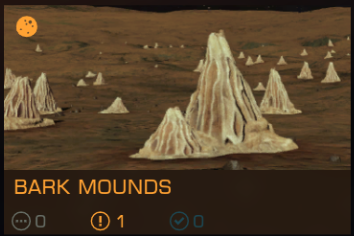
The Bark Mounds can be found on any planet without atmosphere located in a nebula, or close to it (~150 Ly from nebula center). It’s the most common biological POI.
Anemones
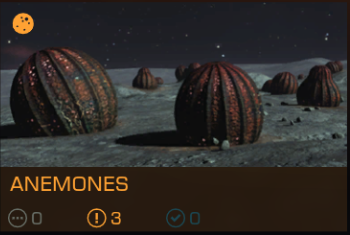
As indicated in the Codex, anemones can be found in systems containing a star of types O, B or more rarely A. Depending upon star type and planet type, the type of anemone varies, having different colors and patterns. Bioluminescents emit light. Note that in addition to the criteria indicated in the Codex, the brightness of the star has an impact on the type of anemones that can be found.
The information on the brightness class, is only visible in the galactic map, in Roman numerals (sometimes there is a subtype after Roman numerals, without utility for anemones):
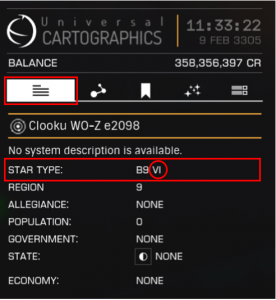
As some brightnesss are much less frequent than others, it is better to target suitable systems (by browsing the filtered galactic map with the type of star of interest) to be able to find each specific type of anemone.
The following table gives the necessary conditions for each type of anemone:
| Star Class + Luminosity | Metal-Rich / HMC | Rocky | Rocky Ice / Icy |
|---|---|---|---|
| O | Prasinus/Prasinum Bioluminescent | Prasinus/Prasinum Bioluminescent | Puniceus/Puniceum |
| B I, B II, B III | Roseus/Roseum Bioluminescent | Roseus/Roseum | |
| B IV, B V | Blattinus/Blatteum Bioluminescent | Luteus/Luteolum | |
| B VI, A III | Rubens/Rubeum Bioluminescent | Croceus/Croceum |
Brain Trees

Brain Trees require a planet with volcanism.
The type of Brain Trees is conditioned by the type of planet, the temperature but also the presence in the system of a Earth-like world (ELW), or a gas giant with life based on water (GG WBL).
The table below shows the appropriate conditions for each type of Brain Trees:
| Type (log) | Type (codex) | Temperature | ELW / GG WBL | Metal-Rich | HMC | Rocky | Rocky Icy |
|---|---|---|---|---|---|---|---|
| Aureus | Aureum | 300K - 500K | X | X | X | ||
| Ostrinus | Ostrinum | Any | X | X | X | ||
| Puniceus | Puniceum | Any | X | X | X | ||
| Cymatilis | Lindigoticum | 300K - 500K | X | X | X | ||
| Carpasinus | Gypseeum | 200K - 300K | X | X | |||
| Livens | Lividum | 300K - 500K | X | X | |||
| Viridans | Viride | 100K - 270K | X | X | |||
| Roseus | Roseum | 200K - 500K | X | X | X | X |
Note that in addition to these criteria, Brain Trees are only present in certain areas. The current hypothesis is that these areas lie around Guardian ruins, however this connection is not yet completely certain.
The practical consequence is that when one finds Brain Trees in a system one can expect to find others in close systems.
Sinuous Tubers

The Sinuous Tubers, according to the codex, require in theory only a Silicates Magma volcanism.
However:
- There are actually several varieties of sinuous tubers (different colors), which are all recorded in the codex under the variety “Roseum sinuous tubers”. (Bug)
- It would seem that, as with the Brain Trees, each variety corresponds to different conditions, but not yet determined (not available in the Codex, and not yet determined by the community).
- In particular, sinuous tubers were found on different types of volcanisms.
- Finally, it seems that the sinuous tubers are more frequent near the Core and perhaps, as for the Brain Trees, grouped by zones.
Crystalline shards

Crystalline shards require:
- A star of type A, F, G, K, M or S.
- A temperature of 0 to 273 K
- Be present in the system, one of the following types of planets:
- Earth-Like World
- Ammonia World
- Gas giant with water based life
- Gas giant with ammonia based life
- Water giant
- Are located only on planets located at least 12 000 Ls from the nearest star.
Note that the crystalline shards appear with fumeroles. So there is at their location both a biological POI and a geological POI.
Amphora plant

The Amphora Plant require:
- Star of type A
- Are on metal-rich planets
- Be present in the system, one of the following types of planets:
- Earth-Like World
- Ammonia World
- Gas giant with water based life (gas giant with water based life)
- Gas giant with ammonia based life (gas giant with ammonia based life)
- Water giant
We suspect that there are additional criteria, not described in Codex, but without certainty. Indeed, even by meeting all the criteria given by the Codex, it is rare to find them.
Geological POI
Geological POIs are found on planets without an atmosphere with volcanism.
Each main type of POI has variants depending on the type of volcanism of the planet. Some combinations are not possible. Also the likelihood of meeting a given type depends heavily on the type of volcanism. The types of Volcanismes are:
- Water geysers (most common)
- Vapour Silicate Geysers
- Carbon dioxide Geysers
- Magma Silicate
- Iron Magma
- Water Magma
- Ammonia Magma (uncommon)
- Methane Magma (uncommon)
- Nitrogen Magma (uncommon)
Each of these types is divided into three “intensities”:
- Major
- Normal (no indication)
- Minor
Ice Fumarole
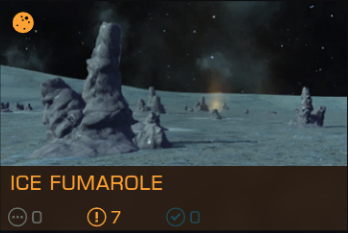
They are found on Icy or Rocky Ice planets only.
| Volcanism | Frequency |
|---|---|
| Water Geysers | Very common |
| Silicate Vapour Geysers | Rare |
| Carbon Dioxide Geysers | Very common |
| Silicate Magma | Occasional |
| Iron Magma | Never |
| Water Magma | Very common |
| Ammonia Magma | Very common |
| Methane Magma | Very common |
| Nitrogen Magma | Very common |
Fumarole
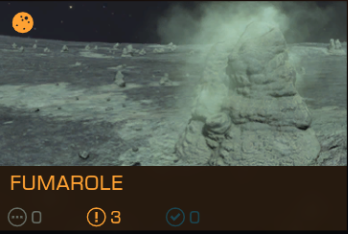
They are found on all types of planets except icy planets.
| Volcanism | Frequency |
|---|---|
| Water Geysers | Rare |
| Silicate Vapour Geysers | Very common |
| Carbon Dioxide Geysers | Never |
| Silicate Magma | Very common |
| Iron Magma | Very common |
| Water Magma | Occasional |
| Ammonia Magma | Never |
| Methane Magma | Never |
| Nitrogen Magma | Never |
Gas Vent

They are found on all types of planets except icy planets.
| Volcanism | Frequency |
|---|---|
| Water Geysers | Rare |
| Silicate Vapour Geysers | Very common |
| Carbon Dioxide Geysers | Occasional |
| Silicate Magma | Very common |
| Iron Magma | Very common |
| Water Magma | Occasional |
| Ammonia Magma | Rare |
| Methane Magma | Rare |
| Nitrogen Magma | Rare |
Ice geyser
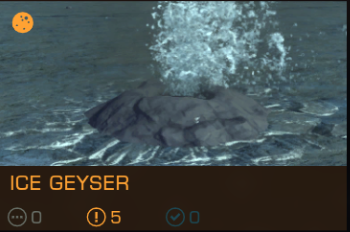
They are found on Icy or Rocky Ice planets only.
| Volcanism | Frequency |
|---|---|
| Water Geysers | Very common |
| Silicate Vapour Geysers | Never |
| Carbon Dioxide Geysers | Very common |
| Silicate Magma | Never |
| Iron Magma | Never |
| Water Magma | Very common |
| Ammonia Magma | Very common |
| Methane Magma | Very common |
| Nitrogen Magma | Very common |
Geyser

They are found on all types of planets, but they are not very common.
| Volcanism | Frequency |
|---|---|
| Water Geysers | Occasional |
| Silicate Vapour Geysers | Occasional |
| Carbon Dioxide Geysers | Occasional |
| Silicate Magma | Rare |
| Iron Magma | Rare |
| Water Magma | Occasional |
| Ammonia Magma | Occasional |
| Methane Magma | Occasional |
| Nitrogen Magma | Occasional |
Lava Spout
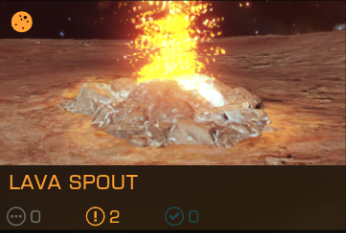
They are found on all types of planets except icy planets.
| Volcanism | Frequency |
|---|---|
| Water Geysers | Never |
| Silicate Vapour Geysers | Very common |
| Carbon Dioxide Geysers | Never |
| Silicate Magma | Very common |
| Iron Magma | Very common |
| Water Magma | Never |
| Ammonia Magma | Never |
| Methane Magma | Never |
| Nitrogen Magma | Never |